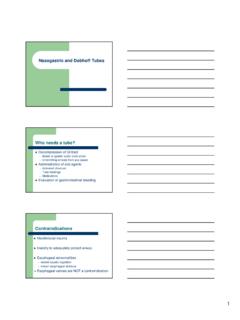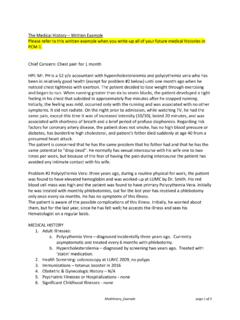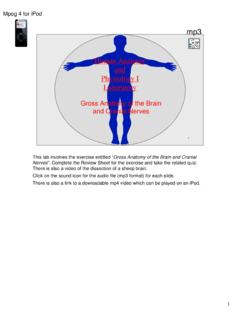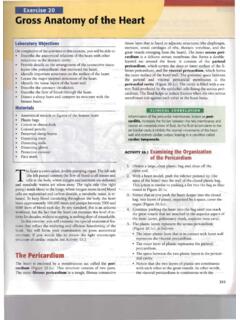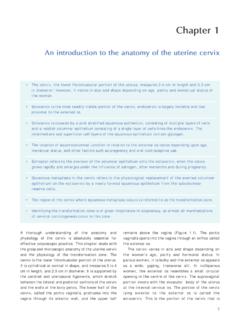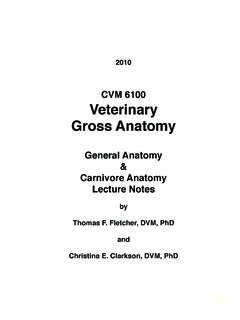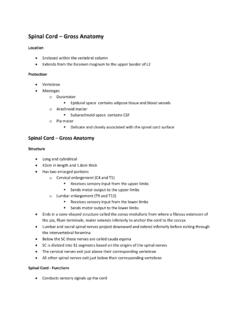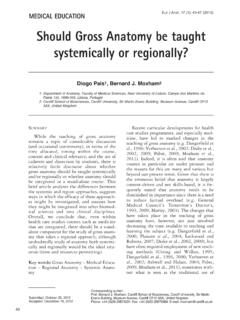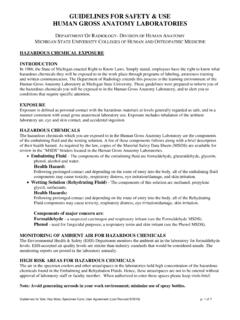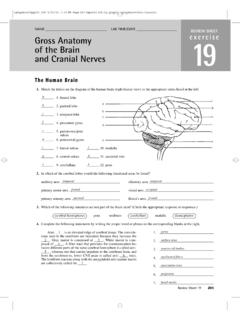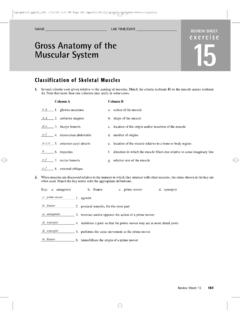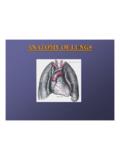Transcription of Dissection Guide 509 - lumen.luc.edu
1 THE ESSENTIAL COMPANION TO CADAVER Dissection A REGIONAL Dissection Guide FOR MEDICAL HUMAN gross anatomy Structure of the Human Body Stritch School of Medicine 2009 Frederick H. Wezeman, Loyola University Chicago Stritch School of Medicine Loyola University Medical Center Maywood, Illinois Copyright 2008 Frederick H. Wezeman - 2 - This Dissection Guide was designed as an aid to human cadaver Dissection by first year medical students. The four fundamental tools of learning gross human anatomy (the cadaver, a Dissection Guide , a textbook, and an atlas) are amplified in their relevance by the use of additional resources now widely available. These include web-sourced radiographic, MRI, and CT images, as well as numerous software programs. In addition, students are advised to use simulation models, plastinated specimens, and prosections to augment their learning.
2 The Dissection of a human body is a privilege given to few. For hundreds of years it has been a pivotal learning experience during the education of a physician. Designed to be part of the first year of all medical curricula, the knowledge gained is foundational to subsequent medical education. No physician has ever entered the field of medicine without adequate training in the anatomical sciences. Recent changes in undergraduate medical curricula are now integrating gross anatomy in the later years of medical school training, and at the graduate medical education level many programs require residents to complete review courses in gross anatomy . The necessity of retained knowledge of gross anatomy is therefore consistently emphasized. I hope that you, as a student, learn as much of this wonderful subject as possible throughout the years of your medical education and continue to increase your knowledge of human structure throughout your career.
3 You and your patients will then be well-served. Frederick H. Wezeman, Professor, Orthopaedic Surgery and Rehabilitation Professor, Cell Biology, Neurobiology and anatomy Associate Dean, The Graduate School Loyola University Stritch School of Medicine Maywood, Illinois 2009 - 3 - Introduction As valuable as detailed Dissection manuals may be, too frequently they are adorned with excessive text, bullet points, figures, highlights and clinical correlations that make them more like a textbook and, as such, arguably less utilitarian during Dissection . This companion is an efficient Guide to Dissection with a specific focus on giving straightforward next step instructions. By virtue of its intended purpose, it leaves the responsibility of gathering primary visual information about structure to the student s parallel use of an atlas or other resources.
4 Adopt a consistent approach to the Dissection and work together as a team. Instruct each other in the small group learning environment by quizzing each other and supporting each other s learning. Participate equally in Dissection . Be professional toward the faculty, each other, and the cadaver. Follow the faculty member's instructions regarding the use of sharp and blunt Dissection techniques. Use proper Dissection instruments at all times. A faculty member will demonstrate proper techniques and you should try to mimic those techniques. As you gain experience your Dissection time will reduce; initially, your progress will be slow. The named structures in this manual can be considered collectively as a find list , although it is cautioned that it is incomplete. Other structures that you will be held responsible for are identified in the required text and recommended atlases.
5 Note: The dates and goals as shown are intended as a Guide to pace the Dissection for the duration of the course, AY 2009-10. In order to stay on schedule during the course students should, at a minimum, complete the Dissection of a region on or about the date given in the companion. Students should be prepared to spend additional Dissection time outside of the formally scheduled lab times. - 4 - Superficial Back October 12 Goals: 1. Orient yourself to the cadaver in the prone position, identifying bony landmarks on the back. 2. Adopt proper Dissection technique for removing skin. 3. Dissect the superficial musculature of the back. Place the cadaver in the prone position. It may be necessary to untie (cut) any rope used to tie the hands together so that the arms can be placed at the side of the body.
6 Palpate (feel with your finger tips) the surface anatomy of underlying structures on the back. Identify the spine of the 7th cervical vertebra (C7). Palpate and count the spinous processes of the thoracic vertebrae down to the first lumbar vertebra if possible. Palpate the scapula's borders and the spine of the scapula. Some cadavers are obese or the fixation makes the skin very firm and palpation cannot be done accurately. In that case, palpate a friend's back and identify the spinous process of C7. Palpate the posterior crest of the ilium. Identify the parts of the axial and appendicular skeleton. Study the structure of the thoracic vertebrae using bone box specimens or a complete hanging skeleton. Locate and name the parts of an individual vertebra; using an intact spine on a hanging skeleton identify the intervertebral foramina where the spinal nerves exit from the spinal column.
7 Remove ONLY the skin from the back from the base of the skull to the lumbar region. Reflect large skin flaps; these will be useful later on to maintain the moisture in the back tissues throughout the course. As the skin is removed note that small vessels and nerves penetrate deeper structures to supply the skin and subcutaneous tissues. Look closely at a small nerve and a small vessel to note the difference in appearance and feel. The small vessels and nerves on the back can be cut during skin removal. The musculature of the back is in two layers. The first layer encountered is comprised of the trapezius and latissimus dorsi muscles. As you begin to learn the musculature of the body you must memorize the following for each muscle: a) name and its correct spelling, b) origin, c) insertion, d) action of the muscle, e) innervation (nerve supply), and f) blood supply.
8 Create the habit of memorizing these in lab; it will greatly reduce the time spent looking these details up later in the day or in the evening when you are studying. Use lab time to both dissect and memorize. Find the borders of each muscle using an atlas and then on the cadaver. Clean a border to orient yourself to the muscle. Blunt dissect the lower surface of the muscle at each border and lift it slightly away from deeper structures to reveal its extent. The flat sheet-like trapezius is the shape of a trapezoid; the latissimus tapers to a large strong tendon that inserts on the humerus. Do not - 5 - cut the lattisimus dorsi. Identify its nerve, the thoracodorsal nerve, and its blood supply, the thoracodorsal artery on its inferior surface. Make a cut through the origin of the trapezius parallel and one inch lateral to the spinous processes.
9 Reflect the muscle laterally to reveal the second layer of muscles beneath it. Identify the nerve to the trapezius (cranial nerve 11, CN11, the spinal accessory nerve) and its blood supply. 4. Dissect the deep layer of muscles, nerves and vessels of the back. The second (deeper) layer of back muscles is comprised of the rhomboid major and minor muscles, and the levator scapula muscle. Quiz each other on the 6 things you need to know about each of these muscles. Dissect the scapular attachment only of the levator scapula; its superior portion is in the neck region. Reflect the rhomboids by a cut inch lateral to their origins. Carefully lift them from underlying structures. Locate the dorsal scapular nerve and artery and the accompanying transverse cervical artery as they make their way into the muscles from above.
10 Note: Because many of the cadavers are old people, their muscles will be thin, having perhaps not been used in many years. Age is a factor in declining body mass, along with disease, lack of exercise, immobilization, and poor nutrition. On the other hand, many cadavers will be large, obese, and well-muscled. Many combinations of these factors will be noted. Please observe other cadavers during the course; you will be tested in lab exams on all of them and you should be able to recognize structures regardless of the attributes of the cadaver. Deep Muscles of the Back and Suboccipital Triangle Cut the latissimus dorsi muscle about 3 inches from the midline and reflect the proximal segment toward the vertebral spines. Identify the posterior superior and posterior inferior serratus muscles. Note the attachments of the posterior layer of the thoracolumbar fascia, then incise it longitudinally from the level of the second rib to the ilium.
